Arpi Travel offers individual and group Regional Tours Armenia - Georgia.
Day 1
Arrival in Tbilisi
Transfer from the airport.
Check-in at the hotel. Free time to relax.
Overnight in Tbilisi.
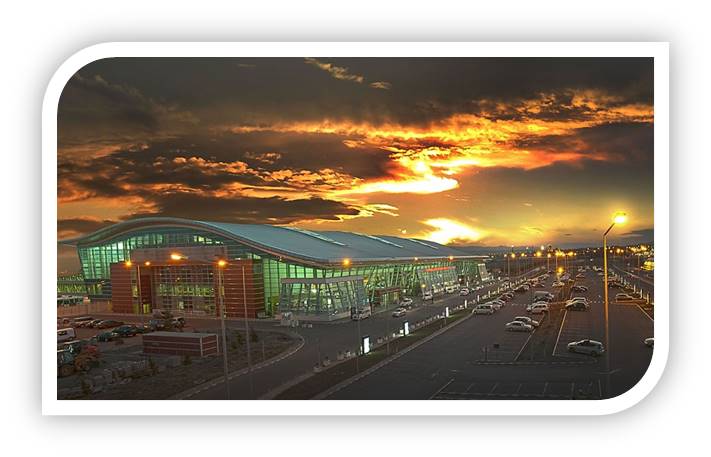
Day 2
Tbilisi - Old Tbilisi - Narikala Fortress - Juma mosque – Abanotubani – Armenian - Gregorian Church - Sioni Cathedral - Walk along the street Charden - The musical miracle clock tower near the Rezo Gabriadze puppet theater - The glass pedestrian bridge of Peace - Sameba Cathedral - Rising by cable car and visiting Mount Mtatsminda (Holy Mountain) - Tbilisi
Breakfast at hotel.
1. City tour in Tbilisi (duration of the tour about 5 - 5,5 hours).
2. The Metekhi Church: it’s 12th century Georgian Orthodox church in the center of Tbilisi on Metekhi cliff. It is the most visible and famous church, the visual symbol of the city which is with the neighborhood of the equestrian statue of Vakhtang Gorgasali (the founder of Tbilisi). The most interesting of this church it’s its portico. One of a very few Golden Age porticoes that has survived the cataclysms of later eras.
3. Old Tbilisi, Narikala Fortress (IV c.) - "The Heart of Tbilisi," - the main fortress of the city. It is located in the very center of the Old City, and locals used to call it “the soul and heart of Tbilisi”. This is wonderful place, it’s worth to visit.
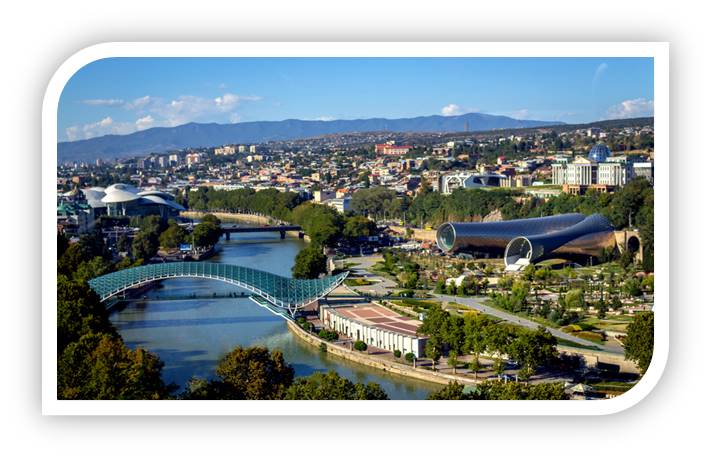
4. Juma mosque - where the local Sunnis and Shiites still pray together. Meydan is not just the historical center of the city, but also the center of eastern culture.
5. Abanotubani - a zone of sulfur baths and “Legvtakhevi” waterfall in the Old City. Baths in Tbilisi are the real attraction of Georgia, part of the centuries-old history of the city, a reflection of the cultural traditions of the Georgian people.
6. Armenian-Gregorian Church - Saint Gevorge is one of the most picturesque churches in Georgia, which has helped Georgian Armenians to maintain their national identity for centuries.
7. Lunchtime
8. Sioni Cathedral - Many Christian countries have holy places that repeat the names of holy places in Palestine.
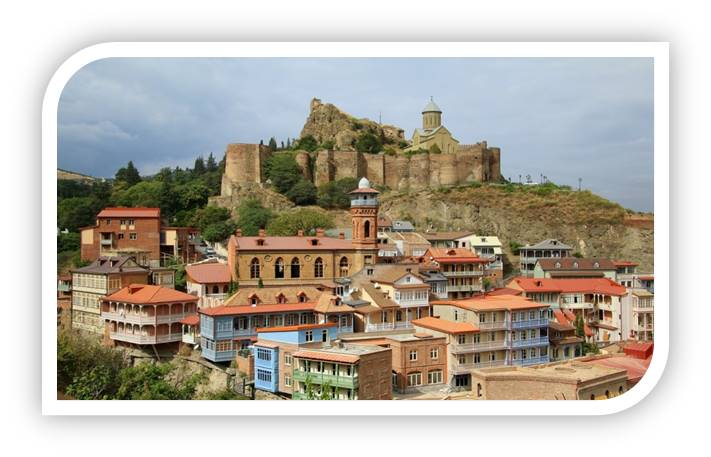
Georgia isn’t exception. Right here, in the capital of Tbilisi, the Zion Cathedral is located. Which is named after the Palestinian mountain.
9. The glass pedestrian bridge of Peace, which symbolically connects the Old City with a European park. Every hour, exactly 30 thousand light bulbs begin to transmit a message in the form of Morse code, in which the names of the elements of the periodic table that are available in the human body are encrypted.
10. Sameba Cathedral or this place is also called, the Holy Trinity Cathedral.
11. Welcome dinner in a restaurant with a national show program (program starts at 20:00)
Overnight in Tbilisi

Day 3
Tbilisi - Bodbe - Sighnaghi - Gremi - Kvareli - Tbilisi
Breakfast at hotel.
1. Departure from the hotel in the direction of Kakheti.
2. The Bodbe Monastery, where rest the relics of the enlightener of Georgia, St. Nina, Equal of the Apostles. It is believed that healing and purifying energy comes from the tomb of St. Nina.
3. A walk in the “City of Love” - Sighnaghi, a renewed city with a view of Alazani Valley and with the ancient traditional style of Georgian architecture. Sighnaghi is built in the mountains, and has the appearance of an octopus, creeping tentacles over individual ridges
4. Lunch at the restaurant.
5. Gremi is an architectural monument of the 16th century - a royal fortress in the Georgian historical region of Kakheti.
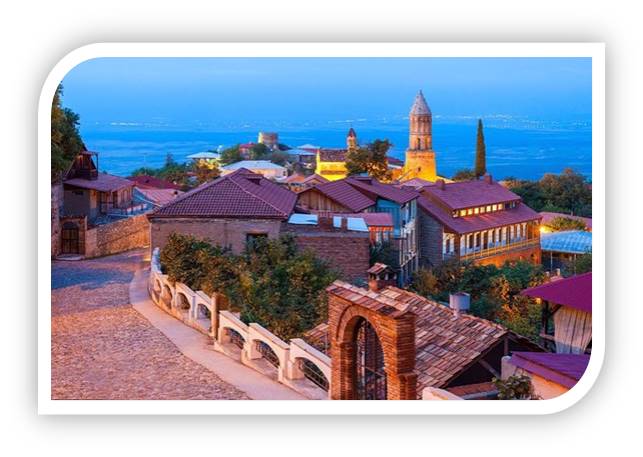
Architectural monument of the 16th century, which includes Royal Citadel and Church of the Archangels.
6. The most famous sort of Georgian wine - “Kindzmarauli” - an excursion in the Kindzmarauli Corporation wine factory and wine tasting (4 sorts), where an experienced winemaker talks about the traditionally Kakheti wine production technology, which is included in the UNESCO intangible cultural heritage list
Overnight in Tbilisi.
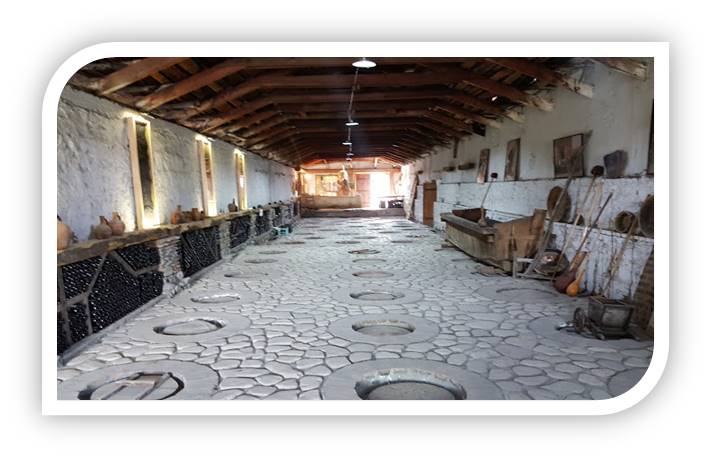
Day 4
Tbilisi - Stepantsminda(Kazbeg) - Gergeti - Gudauri - Ananuri - Tbilisi
Breakfast at hotel.
1. Georgian Military Highway passes through the Main Caucasian Range and connects the cities of Vladikavkaz, North Ossetia, and Tbilisi, Georgia. Its construction began at the end XVIII after signing St. George Treatise in 1783 on the transition of Georgia under the protectorate of the Russian Empire.
2. Cross Pass (2395 m.) - The highest point of Georgian Military Highway.
3. Peoples' Friendship Arch is one of the attractions of Georgian Military Highway. The arch stands at an altitude of 2384 meters. The main reason to stay near the Arch is the observation deck, from which you can clearly see surrounding mountains.
4. S. Stepantsminda is an urban-type settlement in Georgia, built at an altitude of 1744 m above the sea at the foot of Mount Kazbek (5054 m).

Gergeti Trinity Church(XIII-XIV centuries) is the highest cross-domed church in Europe(ascent and descent in 4x4 cars). It stands literally above the clouds-the height above sea level is 2170 meters. From below it seems that the monastery is floating in the air, high-high in the mountains–an amazing view! View of one of the highest peaks of the Caucasus Range-Kazbeg 5054 m.
5. Lunch at the restaurant
6. Alpine zone of the Caucasus-Gudauri ski resort. The main attraction of Gudauri is freeriding-descent through virgin fields. The deep snow cover, the absence of stones, the avalanche danger make Gudari Mecca of freeriding. Also around the resort there is a huge number of off-track slopes for backcountry and heli-skiing.
7. Ananuri Castle Temple(XVII century)-included in the preliminary list of UNESCO World Heritage Sites.
8. The reservoir in Zhinvali is one of the most beautiful and picturesque artificial reservoirs in Georgia. The reservoir area is 11.5 square kilometers.
Overnight in Tbilisi.
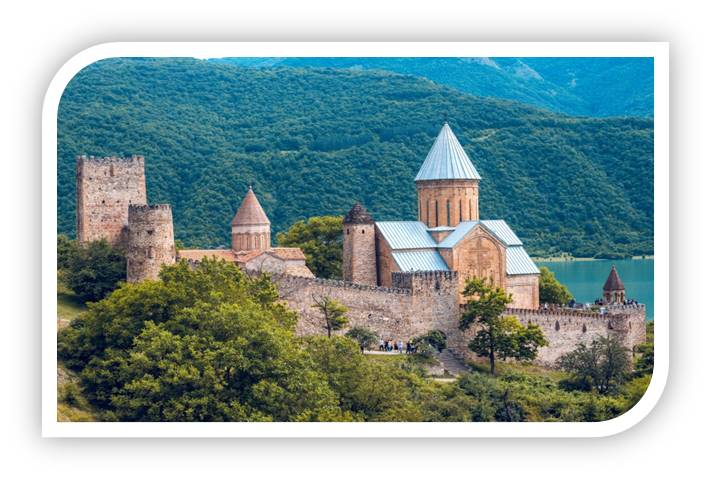
Day 5
Tbilisi - Jvari - Mtskheta - Gori - Borjomi
Breakfast at hotel.
1. Jvari Monastery(VI-VII centuries) - Church of the Holy Cross(UNESCO World Heritage Site) on a mountain near the city of Mtskheta. It is interesting from a historical, landscape, architectural point of view. Jvari is a symbol of Georgian temple architecture and the most important stage in its complicated history.
2. Excursion and walk in the religious center of Georgia-Mtskheta-“Second Jerusalem”, the ancient capital, the source of the spiritual power of Georgia.
3. Svetitskhoveli Cathedral(XI century) - one of the holiest places of Georgia, where one of the main Christian shrines is stored-the Chiton of the Lord(UNESCO-a World Heritage Site). It is the Cathedral by the name of the Twelve Apostles-the first and main temple in Georgia, which name is traditionally translating as "life-giving pillar".

4. G. Gori-the hometown of I. Stalin- visit the museum: his own home and personal armored train. The main attraction of the town is the Stalin House-Museum, built in the form of a marble sarcophagus and with a sculpture of Stalin in front of it, one of the few surviving heritage in the world.
5. Lunch at the restaurant
6. Borjomi-the famous resort town of Georgia, was founded in the middle of the XIX century. A resort in the center of Georgia, famous throughout the Soviet Union for its sources of healing mineral water. Walk in Borjomi park.
7. Degustation of Borjomi mineral water sources, which is used as treatment for the diseases like gastrointestinal tract, biliary tract, metabolism, kidney and bath with cardiovascular diseases, diseases of the nervous system and respiratory organs.
Overnight in Borjomi.
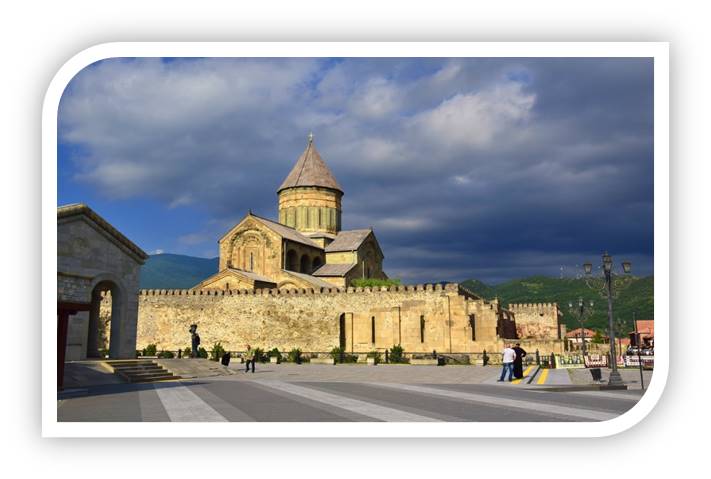
Day 6
Borjomi - Akhaltsikhe - Bavra - Gyumri - Voskevaz - Yerevan
Breakfast at hotel.
1. Akhaltsikhe is a small city in Georgia's southwestern region(mkhare) of Samtskhe–Javakheti.
2. Rabat Fortress-a good example of Georgian tolerance, where along with the Georgian Orthodox Church there is a Catholic church, a synagogue and an Armenian church, a mosque and a madrassah(Muslim educational institution).
3. Khertvisi fortress(X century) is in the preliminary list of UNESCO World Heritage. Once it has belonged to the feudal family, then it was captured by the Turks, later it changed his owners several times, and only in 1828 it was finally returned to Georgia.
4. Lunch at the restaurant.
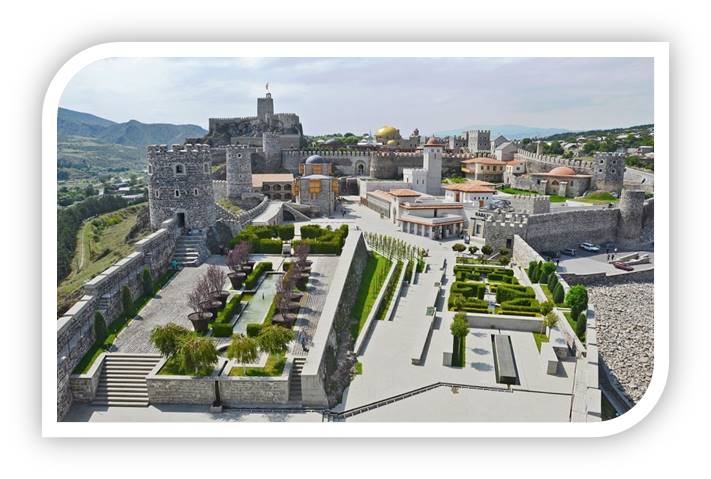
Transfer to Bavra on the border of Georgia - Armenia.
Departure from Georgia. Crossing the Border and Welcome to Armenia.
5. Gyumri is the second largest city in Armenia, a city where you will feel a variety of stunning XIX century architectural styles. By the end of the 19th century, when the city was known as Alexandropol, it was one of the largest cities of Russian-ruled Eastern Armenia with a population similar to that of Yerevan. It was renamed to Leninakan during the Soviet period.
6. Voskevaz winery gives the opportunity to try the best wines, get acquainted with winemaking process and history of wines in Armenia.
Overnight in Yerevan.

Day 7
Yerevan City Tour - Garni Temple - Geghard Monastery - Yerevan
Breakfast at hotel.
1. Yerevan is the administrative, cultural and industrial center of the country. The year of the foundation of Yerevan is 782 BC. E., when King of Urartu Argishti I founded here the fortress city of Erebuni. It has been the capital since 1918, the fourteenth in the history of Armenia and the seventh located in or around the Ararat plain. The city also serves as the seat of the Araratian Pontifical Diocese; the largest diocese of the Armenian Apostolic Church and one of the oldest dioceses in the world. Yerevan Opera Theatre is the main spectacle hall of the Armenian capital, the National Gallery of Armenia is the largest art museum in the Republic of Armenia
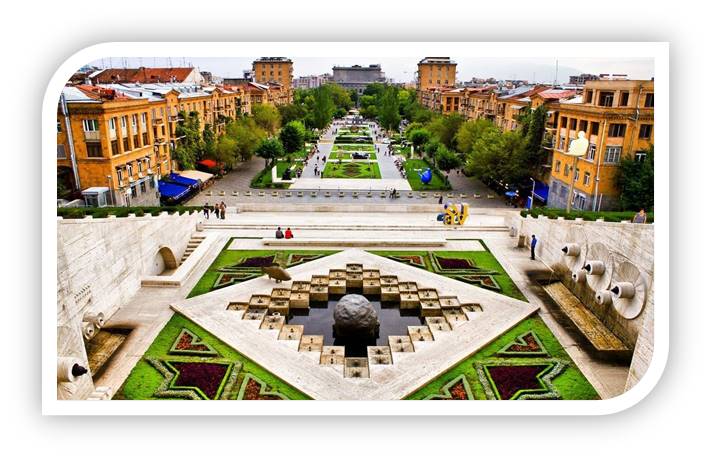
and shares a building with the History Museum of Armenia, and the Matenadaran repository contains one of the largest depositories of ancient books and manuscripts in the world.
2. Tour to Garni _ The Temple of Garni is the only standing Greco-Roman colonnaded building in Armenia and the former Soviet Union. Built in the Ionic order in the village of Garni, Armenia, it is the best-known structure and symbol of pre-Christian Armenia. The structure was probably built by king Tiridates I in the first century AD as a temple to the sun god Mihr. After Armenia's conversion to Christianity in the early fourth century, it was converted into a royal summer house of Khosrovidukht, the sister of Tiridates III. According to some scholars it was not a temple but a tomb and thus survived the destruction of pagan structures. It collapsed in a 1679 earthquake.

Renewed interest in the 19th century led to excavations at the site in early and mid-20th century, and its eventual reconstruction between 1969 and 1975, using the anastylosis method. It is one of the main tourist attractions in Armenia and the central shrine of Armenian neopaganism.
3. Lunch at the restaurant. During the lunchtime traditional bread lavash baking demonstration in tonir (oven in the ground).
4. Then we will keep our way to Geghard _ Geghard monastery (13th century) carved out of the adjacent mountain and initially called Ayrivank the Monastery of the Cave) is included in the World Heritage Site. Due to the fact that the famous spear, with which the Roman soldier wounded Jesus, was kept here for 500 years, the monastery was called Geghardavank (the Monastery of the Spear).
5. The Brandy Factory of Yerevan combines the traditions and practices of the Armenian brandy and gives the opportunity to take a tour in the factory learning about the history of Armenian Cognac.
Overnight in Yerevan.

Day 8
Khor Virap Monastery - Noravanq Monastery - Areni Wine Factory - Goris
Breakfast at hotel.
1. Tour to Khor Virap, which is an Armenian monastery located in the Ararat plain in Armenia, near the closed border with Turkey. Khor Virap's notability as a monastery and pilgrimage site is attributed to the fact that Gregory the Illuminator was initially imprisoned here for 13 years by King Tiridates III of Armenia. Saint Gregory subsequently became the king's religious mentor, and they led the proselytizing activity in the country. In the year 301, Armenia was the first country in the world to be declared a Christian nation.
2. Areni" wine factory was founded in 1994 in the village of Areni on the initiative of the Simonyanov family. Having set the task to continue and enrich the centuries-old traditions of winemaking, offering the consumer high-quality wine of different varieties.

3. Lunchtime.
4. Visit to Noravank, which is a 13th-century Armenian monastery, located 122 km from Yerevan in a narrow gorge made by the Amaghu River, near the town of Yeghegnadzor, Armenia. The gorge is known for its tall, sheer, brick-red cliffs, directly across from the monastery. The monastery is best known for its two-storey Surb Astvatsatsin (Holy Mother of God) church, which grants access to the second floor by way of a narrow stone-made staircase jutting out from the face of building.
5. Drive to city Goris.
Overnight in Goris.
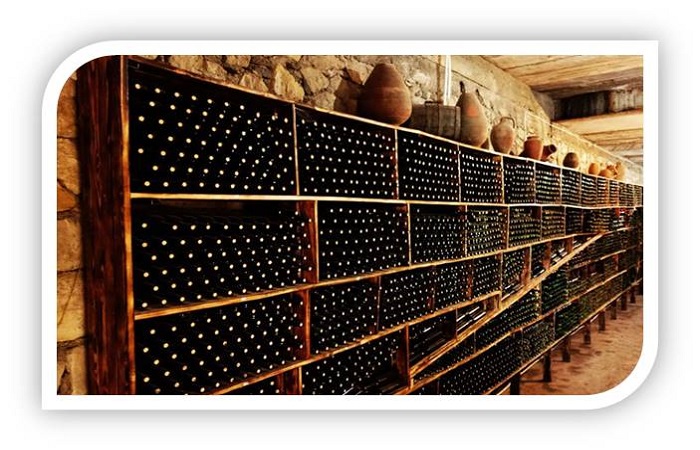
Day 9
Wings of Tatev - Monastery Complex Tatev - Yeghegnadzor Regional Museum - Winery Old Bridge - Jermuk
Breakfast at hotel.
1. Wings of Tatev aerial tramway is located in Syunik region, 250 km to the south of Yerevan. Total ride time from Halidzor station to Tatev monastery is about 12 minutes; a much shorter trip than the 40 minute ride along the steep serpentine road that follows the Vorotan gorge. Flying over the gorge, the aerial tramway cabin reaches its maximum height of 320 meters. When the first cabin reaches the Tatev station, the second one arrives at the Halidzor station. After the Wings are reloaded, the movement starts again in the opposite direction. Each cabin accommodates 30 passengers and one steward. The ropeway can accommodate about 240 passengers per hour. Powerful pillars divide the ropeway into four sections. The longest section is 2.7 km and overlooks the Tatev monastic complex.
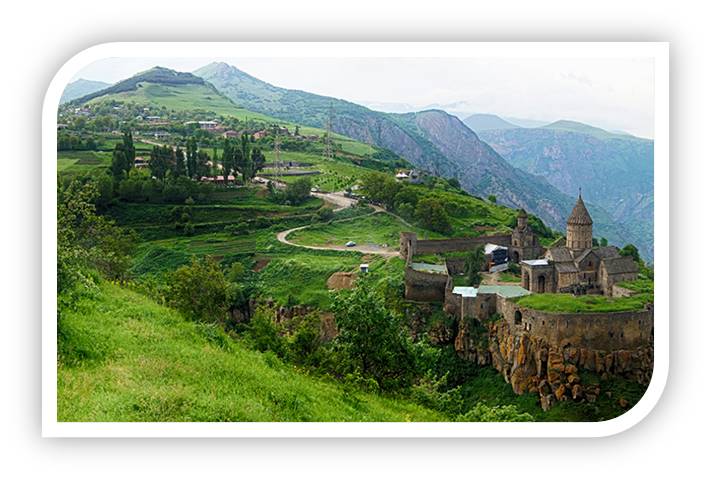
2. Tatev Monastery(9th century) was the most important center of science and education in Armenia. Five hundred monks, philosophers, musicians, artists, correspondence of manuscripts lived in the Tatev Monastery.
3. Yeghegnadzor Regional Museum is a very important center of collecting and preserving cultural heritage from the region.
4. Lunchtime.
5. Old Bridge winery: It owns large vineyards and produces excellent Armenian wines, which are also special for the region.
6. Jermuk spa town. The city-sanatorium Jermuk is located in the south-eastern part of the Republic of Armenia. The plateau is surrounded on three sides by the Syunik mountain ranges, alpine meadows and forest massifs.
Overnight in Jermuk.

Day 10
Jermuk - Selim Pass - Gavar - Lake Sevan - Sevanavank - Yerevan
Breakfast at hotel.
1. Selim Pass (XIV century) was previously an important trade point on the famous Silk Road. It is the only well - preserved caravan-shed in Armenia, built along the Selim pass, it once took tired travelers. There are two inscriptions found on the vestibule, one is written in Persian and the other is written in Armenian.
2. In Gavar there will be a master-class on preparation of Armenian traditional gata. Gata is an Armenian pastry or sweet bread. There are many variations of gata in Armenia and typically specific towns or regions will have their own version. It can be found in a variety of shapes, sizes and may be decorated or left unadorned. Long ago, gata was baked in a tonir, but it is now baked in ovens. The bread is traditionally eaten at the feast of Candlemas, but is eaten during other festivities too or simply baked to enjoy with a cup of tea or coffee.
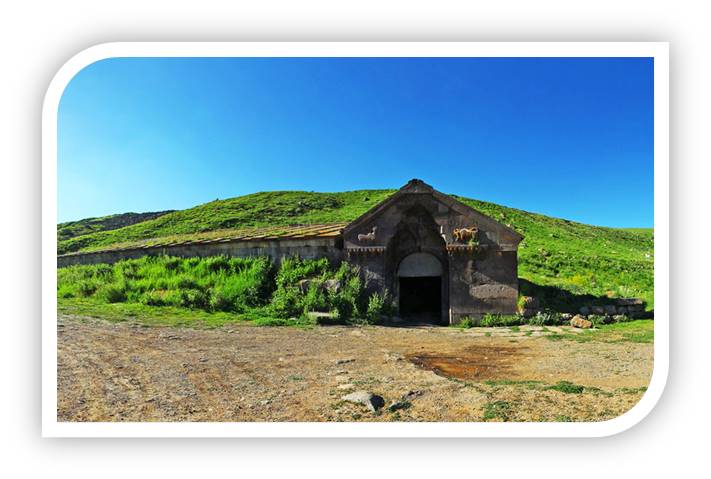
3. Lunchtime.
4. Lake Sevan is located in the Gegharkunik region, about 1900 meters above sea level. This is the second largest fresh water lake in the world․ Sevan is famous for its fish, especially․ Along with Lake Van and Lake Urmia, Sevan is considered one of the three great "seas" of historic Armenia. It is the only one within the boundaries of present-day Republic of Armenia, while the other two are located in Turkey and Iran, respectively. Lake Sevan is considered the "jewel" of Armenia and is "recognized as a national treasure" in the country. The monastery was founded in 874 AD by Princess Mariam, the daughter of Ashot I Bagratuni.
6. Drive to city Yerevan.
Overnight in Yerevan.

Day 11
Airport Transfer
Transfer from the hotel to airport.
Departure from Armenia.
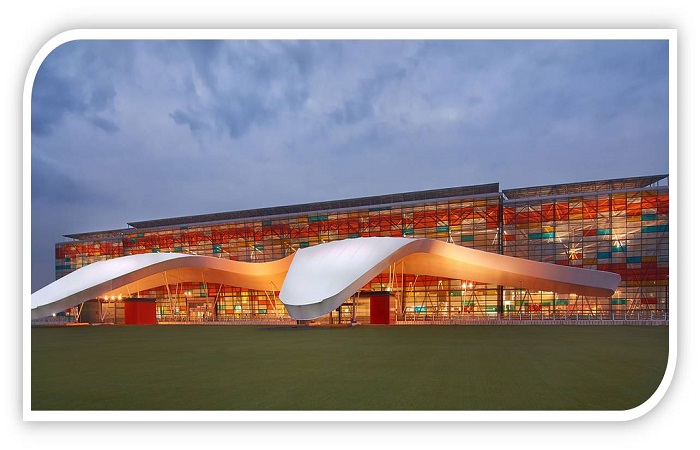
| The price of the tour included: | |
|---|---|
| Airport transfers | |
| Accommodation in hotels(3* double rooms) | |
| Meals (Breakfast + Lunch) | |
| High quality transport services with air conditioner | |
| Professional guide service | |
| Entrance tickets (Included in the tour, wine tastings) | |
| 1 bottle (0,5 l) of water per day |
| The price not included: | |
|---|---|
| Air tickets | |
| Travel insurance | |
| Alcoholic drinks | |
| Visa | |
| Note: | |
|---|---|
| • Depending on weather conditions and force majeure situations, the tour package may be changed. | |
| • Depending on arrival datas, there may be changes in program connected with reservations. | |